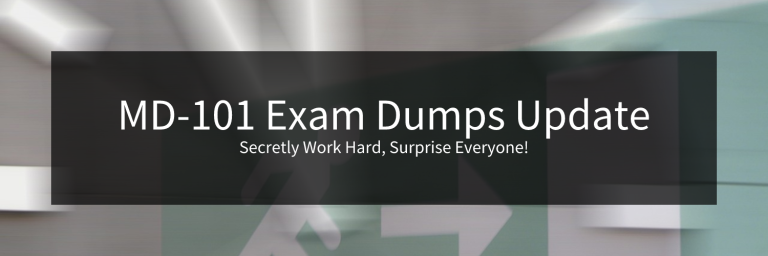How to prepare Microsoft 70-410 dumps exam? Some people find a better way that is choosing https://www.pass4itsure.com/70-410.html dumps: Installing and Configuring Windows Server 2012 exam questions. Candidates can register Microsoft 070-410 dumps Windows Server exam at pass4itsure testing center. The Installing and Configuring Windows Server 2012 (70-410 dumps) version is tested with 503 questions in pass4itsure that validate knowledge of to implement a core Windows Server 2012 infrastructure in an existing enterprise environment. Passing this exam validates a candidate’s ability to implement and configure Windows Server 2012 core services, such as Active Directory and the networking services.
- Exam Code: 070-410
- Exam Name: Installing and Configuring Windows Server 2012
- Instant Download After Purchase
- 100% Money-Back Guarantee
- 365 Days Free Update
- 7000+ Satisfied Customer
- 6000+ Exam Q&As
- 6000+ Free Demo
- 98% Pass Rate
- 100% Money-Back Guarantee
- 365 Days Free Update
- 5 Years of Working Experience
[2018-NEW Pass4itsure 70-410 PDF Dumps From Google Drive]: https://drive.google.com/open?id=0BwxjZr-ZDwwWbWdtSVRYVmpQa0U
[2018-NEW Pass4itsure 70-413 PDF Dumps From Google Drive]: https://drive.google.com/open?id=0BwxjZr-ZDwwWYkpNOFdaS1QtcUE
Pass4itsure Latest and Most Accurate Microsoft 70-410 Dumps Exam Q&As(1-8)
QUESTION 1
You work as a senior administrator at CertBus.com. The CertBus.com network consists of a single domain named CertBus.com. All servers on the CertBus.com network have Windows Server 2012 installed, and all workstations have Windows 8 installed. You are running a training exercise for junior administrators. You are currently discussing the Always Offline Mode. Which of the following is TRUE with regards to the Always Offline Mode? (Choose all that apply.)
A. It allows for swifter access to cached files and redirected folders.
B. To enable Always Offline Mode, you have to satisfy the forest and domain functional-level requirements, as well as schema requirements.
C. It allows for lower bandwidth usage due to users are always working offline.
D. To enable Always Offline Mode, you must have workstations running Windows 7 or Windows Server 2008 R2.
070-410 exam Correct Answer: AC
Explanation
Explanation/Reference:
Offline Files have four modes of operation:
Online
Slow link
Auto offline
Manual offline
Offline Files transition between the three modes online, slow link, and auto offline depending on connection speed. The user can always override the automatic mode selection by manually switching to manual offline mode. To determine the connection speed two pings with default packet size are sent to the file server. If the average round-trip time is below 80 ms (Windows 7) or 35 ms (Windows 8), the connection is put into online mode, otherwise into slow link mode. The latency value of 35/80 ms is configurable through the Group Policy setting Configure slow-link mode.
Reads, Writes, and Synchronization In online mode, changes to files are made on the file server as well as in the local cache (this induces a performance hit – see this article for details). Reads are satisfied from the local cache (if in sync). In slow link mode, changes to files are made in the local cache. The local cache is the background- synchronized with the file server every 6 hours (Windows 7) or 2 hours (Windows 8), by default. This can be changed through the Group Policy setting Configure Background Sync. In auto offline mode, all reads and writes go to the local cache. No synchronization occurs. In manual offline mode, all reads and writes go to the local cache. No synchronization occurs by default, but background synchronization can be enabled through the Group Policy setting Configure Background Sync.
QUESTION 2
Your network contains an Active Directory domain named adatum.com. The computer accounts for all member servers are located in an organizational unit (OU) named Servers. You link a Group Policy object (GPO) to the Servers OU. You need to ensure that the domain’s Backup Operators group is a member of the local Backup Operators group on each member server. The solution must not remove any groups from the local Backup Operators groups. What should you do?
A. Add a restricted group named adatum\Backup Operators. Add Backup Operators to This group is a member of the list.
B. Add a restricted group named adatum\Backup Operators. Add Backup Operators to the Members of this group list.
C. Add a restricted group named Backup Operators. Add adatum\Backup Operators to This group is a member of the list.
D. Add a restricted group named Backup Operators. Add adatum\Backup Operators to the Members of this group list.
Correct Answer: A
Explanation
Explanation/Reference:
A. The Member Of list specifies which other groups the restricted group should belong to B. Needs to be added to member of the list
C. Wrong group
D. Wrong group
Restricted groups allow an administrator to define two properties for security-sensitive groups (that is, “restricted” groups).
The two properties are Members and Member Of. The Members list defines who should and should not belong to the restricted group. The Member Of list specifies which other groups the restricted group should belong to. When a restricted Group Policy is enforced, any current member of a restricted group that is not on the member’s list is removed. Any user on the Members list which is not currently a member of the restricted group is added. The Restricted Groups folder is available only in Group Policy objects associated with domains, OUs, and sites. The Restricted Groups folder does not appear in
the Local Computer Policy object. If a Restricted Group is defined such that it has no members (that is, the Members list is empty), then all members of the group are removed when the policy is enforced on the system. If the Member Of list is empty no changes are made to any groups that the restricted group belongs to. In short, an empty Member list means the restricted group should have no members while an empty Member Of list means “don’t care” what groups the restricted
group belongs to.

QUESTION 3
Your network contains an Active Directory domain named contoso.com. All servers run Windows Server 2012 R2. An application named Appl.exe is installed on all client computers. Multiple versions of Appl.exe are installed on different client
computers. Appl.exe is digitally signed. You need to ensure that only the latest version of Appl.exe can run on the client computers. What should you create?
A. An application control policy packaged app rule
B. A software restriction policy certificate rule
C. An application control policy Windows Installer rule
D. An application control policy executable rule
70-410 dumps Correct Answer: D
Explanation
Explanation/Reference:
A. A publisher rule for a Packaged app is based on publisher, name, and version B. You can create a certificate rule that identifies software and then allows or does not allow the software to run, depending on the security level.
C. For .msi or .msp
D. Executable Rules, for .exe and can be based on Publisher, Product name, filename, and version. Use Certificate Rules on Windows Executables for Software Restriction Policies This security setting determines if digital certificates are processed when a user or process attempts to run the software with a .exe file name extension. This security setting is used to enable or disable certificate rules, a type of software restriction policies rule. With software restriction policies, you can create a certificate rule that will allow or disallow software that is signed by Authenticode to run, based on the digital certificate that is associated with the software. In order for certificate rules to take effect, you must enable this security setting. When certificate rules are enabled, software restriction policies will check a certificate revocation list (CRL) to make sure the software’s certificate and signature are valid. This may decrease performance when starting signed programs. You can disable this feature. On Trusted Publishers Properties, clear the Publisher and Timestampcheck boxes.
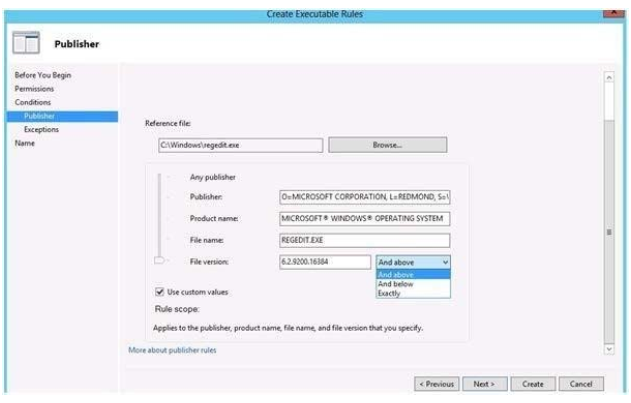
QUESTION 4
You have a server named Server1 that runs Windows Server 2012 R2. You add a 4-TB disk named Disk 5 to Server1. You need to ensure that you can create a 3-TB volume on Disk 5. What should you do?
A. Create a storage pool.
B. Convert the disk to a dynamic disk.
C. Create a VHD, and then attach the VHD.
D. Convert the disk to a GPT disk.
Correct Answer: D
Explanation
Explanation/Reference:
MBR max is 2TB, the disk must be GPT
For any hard drive over 2TB, we need to use GPT partition. If you have a disk larger than 2TB size, the rest of the disk space will not be used unless you convert it to GPT. An existing MBR partition can’t be converted to GPT unless it is completely empty; you must either delete everything and convert or create the partition as GPT. It is not possible to boot to a GPT partition, impossible to convert MBR to GPT without data loss.
QUESTION 5
Your network contains two servers named Server1 and Server2 that run Windows Server 2012 R2. You need to install the Remote Desktop Services server role on Server2 remotely from Server1. Which tool should yo
A. The dsadd.exe command
B. The Server Manager console
C. The Remote Desktop Gateway Manager console
D. The Install-RemoteAccess cmdlet
070-410 pdf Correct Answer: B
Explanation
Explanation/Reference:
A. Adds specific types of objects to the directory
B. You can manage the remote server by Server Manager and install roles/features C. Remote Desktop Gateway (RD Gateway) is a role service that enables authorized remote users to connect to resources on an internal corporate or private network, from any Internet-connected device that can run the Remote Desktop Connection (RDC) client. D. Performs prerequisite checks for DirectAccess (DA) to ensure that it can be installed, installs DA for remote access (RA) (includes management of remote clients) or for management of remote clients only, and install VPN (both Remote Access VPN and site-to-site VPN).
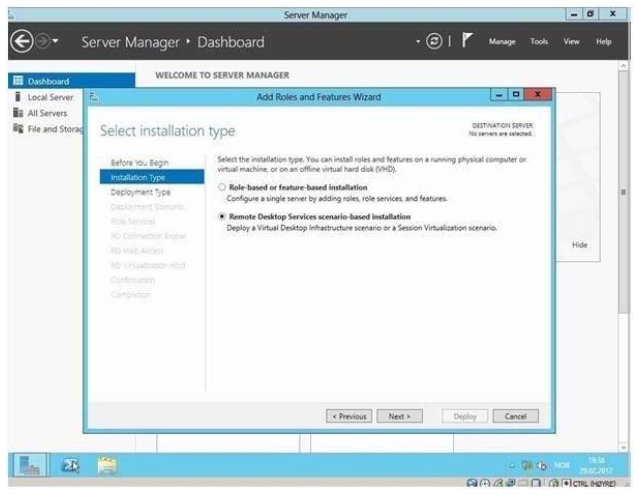
QUESTION 6
Your network contains a server named Server1 that runs Windows Server 2012 R2. Server1 has the Hyper-V server role installed. Server1 hosts four virtual machines named VM1, VM2, VM3, and VM4. Server1 is configured as shown in the following table.
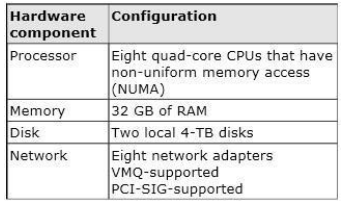
You install Windows Server 2012 R2 on VM2 by using Windows Deployment Services (WDS). You need to ensure that the next time VM2 restarts, you can connect to the WDS server by using PXE. Which virtual machine setting should you configure for VM2?
A. NUMA topology
B. Resource control
C. Resource metering
D. Virtual Machine Chimney
E. The VLAN ID
F. Processor Compatibility
G. The startup order
H. Automatic Start Action
I. Integration Services
J. Port mirroring
K. Single-root I/O virtualization
70-410 vce Correct Answer: G
Explanation
Explanation/Reference:
G. Configure the BIOS of the computer to enable PXE boot, and set the boot order so that it is booting from the network is first
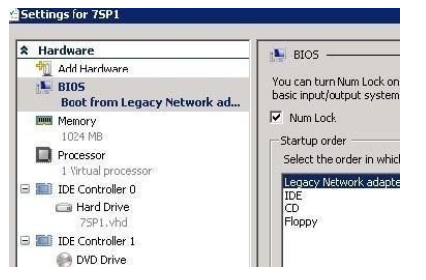
QUESTION 7
Your network contains an Active Directory domain named adatum.com. The domain contains three domain DC3 loses network connectivity due to a hardware failure. You plan to remove DC3 from the domain. You log on to DC3. You need to
identify which service location (SRV) records are registered by DC3. What should you do?

A. Open the %windir%\system32\config\netlogon.dns file.
B. Run dcdiag /test:dns
C. Open the %windir%\system32\dns\backup\adatum.com.dns file.
D. Run ipconfig /displaydns.
070-410 exam Correct Answer: A
Explanation
Explanation/Reference:
A. Netlogon service creates a log file that contains all the locator resource records and places the logfile in the following location:
B. Analyzes the state of domain controllers in a forest or enterprise and reports any problems to help in troubleshooting.
C. DNS backup file
D. used to display current resolver cache content You can verify SRV locator resource records by viewing netlogon.DNS, located in the
%systemroot%\System32\Config folder.
The SRV record is a Domain Name System (DNS) resource record that is used to identify computers that host specific services.
SRV resource records are used to locate domain controllers for Active Directory. You can use Notepad, to view this file. The first record in the file is the domain controller’s Lightweight Directory Access Protocol (LDAP) SRV record. This record should appear similar to the following: _ldap._tcp.Domain_Name
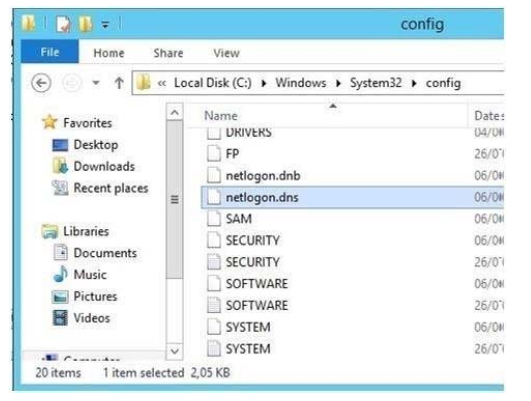
QUESTION 8
Your network contains an Active Directory domain named contoso.com. All domain controllers run Windows Server 2008 R2. One of the domain controllers is named DCI. The network contains a member server named S Windows Server 2012 R2. You need to promote Server1 to a domain controller by using install from media (IFM). What should you do first?
A. Create a system state backup of DC1.
B. Create IFM media on DC1.
C. Upgrade DC1 to Windows Server 2012 R2.
D. Run the Active Directory Domain Services Configuration Wizard on Server1.
E. Run the Active Directory Domain Services Installation Wizard on DC1.
Correct Answer: C
Explanation
Explanation/Reference:
A. Backs up system state data to be restored
C. Only a valid option. You could install ADDS role on Server 1 and run ADDS configuration wizard and add DC to an existing domain
D. Need to add ADDS role first
E. Wrong server
Installation from media does not work across different operating system versions. In other words, you must use a Windows Server 2012 R2 domain controller to generate installation media to use for another Windows Server 2012 R2 domain controller installation. We can use the Install from media (IFM) option to install an Additional Domain Controller in an existing domain is the best option such as a branch office scenario where the network is slow, unreliable, and costly. IFM will
minimize replication traffic during the installation because it uses restored backup files to populate the DS database. This will significantly reduce the amount of traffic copied over the WAN link.
Things to remember:
If you are deploying your first Domain Controller in the domain, you cannot use IFM. The OS will need to match the IFM media. (If you create a 2008 R2 IFM, promote a 2008 R2 DC) If you are creating a DC that will be a Global Catalog Server, create your IFM on a Global Catalog Server. If you are creating a DC that will be a DNS Server, create your IFM on a DNS Server. If you want to copy the SYSVOL, the DC on which you generate the installation media and the new DC must be at least running Windows Server 2008 with Service Pack 2 or Windows Server 2008 R2. Membership of the Domain
Do you provide free updates?
Yes, once there are some changes on the pass4itsure 70-410 dumps exam, we will update the study materials timely to make sure that our customer can download the latest edition. The updates are provided free for 120 days.
The Installing and Configuring Windows Server 2012 exam is an assessment with 503 questions in pass4itsure. There are some questions in real pass4itsure 70-410 dumps exam, which will take the candidate’s minutes about Installing and Configuring Windows Server 2012 course. The associated certifications of Microsoft 70-410 Windows Server exam are MCP, MCSA, MCSE. The available language is English, Chinese (Simplified), French, German, Japanese, Portuguese (Brazil).

Pass4itsure is one of such ideal platform and you can select us if you want to prepare 70-410 new questions offered by Microsoft exams especially
They just need to take care of the best kind of preparation of their Microsoft certifications so, that they don’t have to face failure. Though, so many of the MCP, MCSA, MCSE experts appear in 70-410 dumps certification exam every year and make their future.
All our 70-410 dumps are updated within a span of 90 days and it’s completely free. This makes sure that you are on the right track in your preparation. These PDF files are easily available through downloading from the website. Pass4itsure gives you flexibility in your preparation. The question-answers are aligned with pass4itsure 70-410 dumps exam dumps syllabuses.
Read More:https://www.certadept.com/most-popular-cisco-600-460-dumps-exam.html
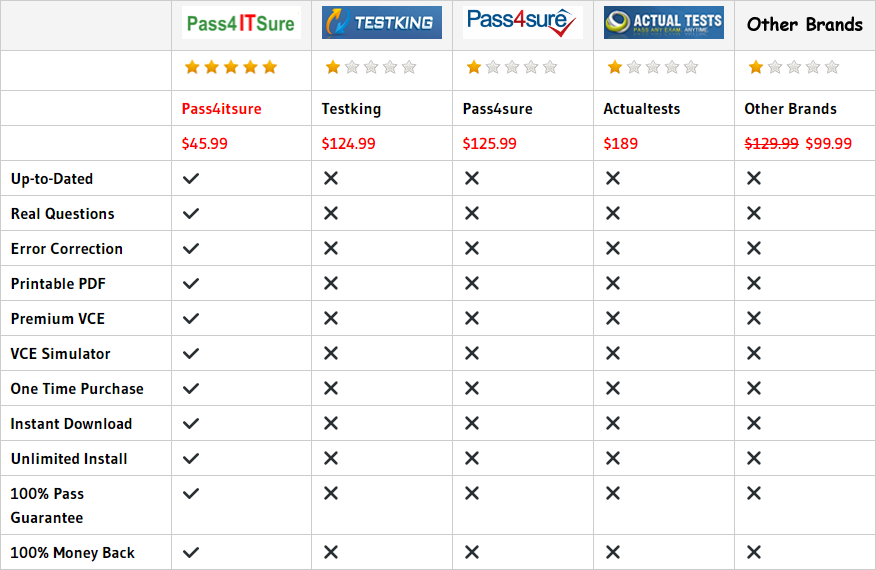
Pass4itsure Microsoft 70-410 Dumps PDF, Free Microsoft 70-410 Dumps Tests Covers All Key Points, We Help You Pass Installing and Configuring Windows Server 2012.
Pass4itsure Promo Code 15% Off



